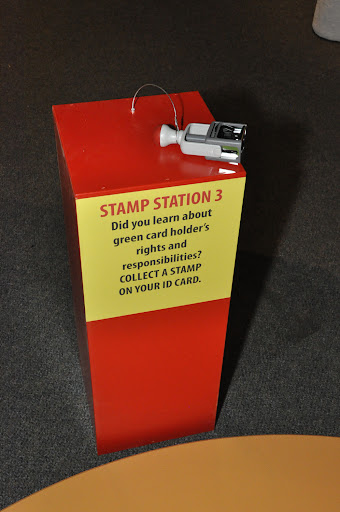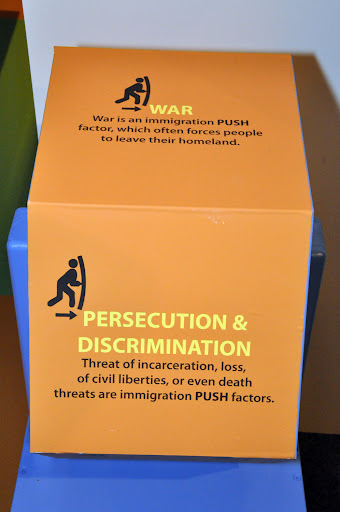The San Antonio Institute of Texan Cultures, a multicultural education center, library, and museum, is showcasing a new exhibit titled “Why We Came: The Immigration Experience.” The exhibit chronicles the personal journeys of more than a dozen new immigrants who chose to settle in Texas.
“I did interviews with a number of first-generation immigrants who represented all kinds of experiences. One of them escaped from Cambodia during the Khmer Rouge,” said Sarah Gould, the exhibit curator and lead researcher who joined the ITC two years ago.
The ITC is an outgrowth of the 1968 HemisFair and is situated in HemisFair Park just a short walk from the historic Alamo mission. In 1969, the ITC became part of the University of Texas at San Antonio. Since then, UTSA has been under state mandate to promote multiculturalism through exhibits and many multicultural education programs.
That’s why ITC, a 182,000 square-foot complex with 65,000 square feet of usable space, spends time, money, and research hours searching for Texas’ ethnic and cultural diversity beyond its original Native American and pre-statehood Hispanic heritage. To this end, ITC launched an oral history program in 1972. But it was the “New Texan” project that inspired Gould to suggest the new exhibit.
“I was working on the New Texan project, which is only a couple of years old. But once I heard all these great immigration stories, I started thinking of how this is something we encounter every day. So this exhibit grew out of oral history stories,” said Gould, whose own family originally emigrated from Monterrey, Mexico.
Gould spent more than a year interviewing and researching the project. Then together with other staffers, they designed and developed the new exhibit. Visitors may empathize with the plight of recent immigrants when they see photographs, letters, a video, a giant box of French fries, and a white inner tube.

“One person told me the first American food they had was a box of French fries, so we had a designer come up with this to illustrate that,” said Gould, pointing to an enormous white box filled with white sticks representing the popular fast food.
“Many of our previous exhibits are object-based, but this one is a little different in that it is an interactive exhibit. For example, in a past exhibit we had someone working on a chuck wagon. In this exhibit visitors are immersed in the immigration process. They experience what it’s really like to be an immigrant from the time they arrive until they take their citizenship exam,” she said.

Although undocumented immigration has grabbed headlines for two decades, immigration is neither a new phenomenon nor exclusive to the U.S. What is new is the erroneous national perception that immigrants are a threat to the economy and a burden to American society.
In reality, immigrants from Mexico and Spain settled in Texas long before newcomers revolted. Consequently, Texas declared its independence from Mexico in 1836 and remained a sovereign nation until its annexation in 1845. But before the arrival of Mexicans and Europeans, Native Americans lived in “Tejas,” so called by the Spanish in reference to the Caddo Indians of East Texas.
Fast forward 200 years plus and the reality is that immigration to the U.S. has become a complex and expensive endeavor. Moreover, to enter and remain-even legally-can be a lengthy process mired in red tape legalities.
This exhibit tries to show some of the problems immigrants face when they emigrate and come to a new country. Some of the challenges they face are legal, social, emotional, and economic issues. And if they don’t speak English, that’s just another obstacle they have to overcome, Gould said.
One factor that makes this exhibit unique is the participation of new, local immigrants from Iran, Cambodia, Vietnam, India, Africa, and other countries. Their willingness to candidly share their personal stories provides a better understanding of why they emigrated from their homelands and arrived here.
“I had two main goals with this exhibit: one was to dispel some misconceptions associated with immigration. The other is to personalize the experience, because when you personalize any kind of history, you have a better understanding,” said Gould.
When visitors enter the exhibition, the first item they see is a wall of photographs of the new Americans and proud Texans. It’s easy to see that this is not a typical museum exhibit. The interactive journey puts the viewer on a board game. Visitors pick color-coded cards to begin their journey as an immigrant.

While some of those interviewed for the exhibit date their arrival to 1958, others are truly new Texans and American citizens. Moreover, immigrant subjects abound thanks to a monthly citizenship ceremony that has been ongoing for decades. Visitors can see a video of the process hosted by a judge.
In 2010, ITC became part of the Smithsonian Institution Affiliates Program. Now it has access to a cache of historical and educational information. Beyond the “Why We Came” exhibit, which will be on display through March 2014, the ITC has both permanent and temporary exhibits.
The ITC is a museum and learning center committed to working with educators. That’s why one of the exhibit props includes a push-pull exercise. The exercise prepares 4th to 8th graders for the Texas Essential Knowledge and Skills test, which is a good example of how the multi-faceted facility complies with state-mandated educational goals.
Admission for ages 12 to 64 is $8.oo. For 65 years or older, admission is $7.00. Admission for children 3-11 is $6. 2 years old or under are admitted for free.
Visit UTSA’s ITC at http://www.texancultures.com/ for more information. Anyone planning a summer vacation can easily include a visit to ITC while touring the historic landmarks. Contact the San Antonio Convention & Visitor’s Bureau at visitsanantonio.com
Rosie Carbo is the Lifestyles Editor for Wandering Educators,
and is a former newspaper reporter whose work has appeared in newspapers
and magazines nationwide. Some of those publications include People
magazine, The Dallas Morning News, The Houston Chronicle and San Antonio
Express-News. Some of her features were redistributed by The Associated
Press early in her career as an award-winning Texas journalist.
